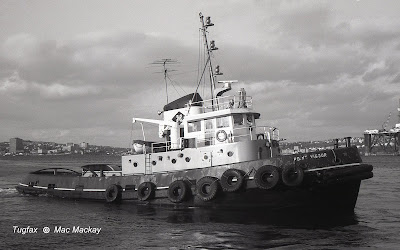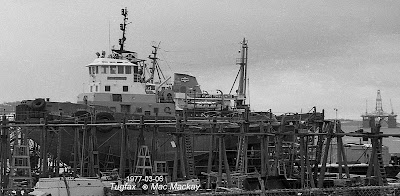In my previous post I made note of the six sister tugs built for Foundation Maritime in 1962. Remarkably, three are still operating, and are likely to put in several more years of service.
Since this year marks their 60th anniversary I will expand a bit upon the careers of each of the six tugs. My plan is to stretch the story over several months. Although the tugs were built in December of 1962 and a larger follow-on tug in June 1963, I will be extending this series to "before" and "after" - going back to the 1950s, and extending to a few years later.
Context
The Foundation Company of Canada was an offshoot of a large US construction company. A pioneer in the use of pneumatic caissons, they established Canadian headquarters in Montreal but had marine construction projects throughout eastern Canada. Their more or less accidental entrance into marine towing and salvage in the 1930s is most amusingly recounted by Farley Mowat in Grey Seas Under - required reading for any tug entusiast.
The exploits of the salvage tug Foundation Franklin make exciting reading in Mowat's book Grey Seas Under. A following book The Serpent's Coil tells of the salvage tug Foundation Josephine and its rescue of the cargo ship Leicester
The company's success in salvage work was only one part of their business. In order to provide a year round marine base, the Foundation Company purchased the Halifax Towboat operation and renamed it Maritime Towing + Salvage. It expanded to provide harbour tug services in Halifax, Sept-Iles, Baie Comeau and Port Alfred, as well as general towing. As Mowat relates, the company had to make do with a rag tag collection of old boats during war time. Following the conflict they were able to upgrade a couple of the boats to diesel and to buy some war-built tugs, but some of these were also inefficent steamers - built cheaply and "for the duration", and with a hodgepodge of power plants and machinery.
The Bansun (foreground) had been a non-condensing steam tug from the Geat Lakes, acquired during World War II and converted to diesel post-war. As a steam tug it had to return to the dock frequently to replenish its fresh water supply since briny harbour water filled the boiler tubes with scale. The tugs "chugged" like steam locomotives. Its coal burning sister tug Banstar (background) had yet to be converted when the above photo was taken.
Several small war built "Glen" class tugs were acquired,but were low powered and not up to the job of docking large ships. It took up to six tugs to berth the Queen Elizabeth and Queen Mary for example. In the mid 1950s with the iron ore port of Sept-Iles and the grain, aluminum and paper port of Baie Comeau demanding bigger and more powerful tugs Foundation turned to the pre-eminent Canadian shipyard Davie Shipbuilding + Repairing Ltd in Lauzon, QC (then owned by Canada Steamship Lines). CSL / Davie also operated the tugs in Quebec City and had already begun to upgrade its fleet with new diesel tugs. They had both operating experience and excellent in house design capabilities. Incidentally, Foundation operated its salvage tug from Lauzon seasonally, so knew the Quebec tugs from close observation and co-operation.
In the 1950s and 1960s the Foundation Vigilant was based in Lauzon in the summer and moved to Bermuda in the winter, but ranged far and wide as needed.Foundation first contracted for two big ice stengthened harbour tugs for use in Sept-Iles but with the ability to cover Baie Comeau. Foundation Victor was built in 1956 and Foundation Valour in 1958. They were single screw tugs of 1280 bhp, and worked most of the year in Sept-Iles but returned to Halifax during the dead of winter as there was generally no winter navigation in the Gulf or river between late December and the end of April, and Halifax was a busy "winter port" handling shipping diverted from the St.Lawrence.
Foundation Victor's high wheelhouse provided good visibility for ship berthing work.The tugs were "triple deckers", built with a wheelhouse elevated above the officers' cabins to permit easier all round viewing and of the decks of large ships. This pattern was an improved version of the unheated but enclosed flying bridge of the earlier pre-war and war built steam tugs. The feature was continued with later tugs all the way to 2005, so obviously it was a succesful design feature.
The Scottish built Banscot was among the tugs acquired by Foundation Maritime when they bought the Halifax harbour tug business. It had an open fly bridge with a crude weather enclosure. The war built Foundation Vera orginally had an open "monkey island" flying bridge, which Foundation enclosed to make weather tight. Tug skippers preferred the elevated position for its better visibility.
In the 1970s the Foundation Company sold the tug business to Marine Industries Ltd of Sorel, QC which formed MIL Tug. However that company was soon resold to a joint venture between the Dutch Smit International and the British company Cory Towage, forming Eastern Canada Towing [ECTUG]. Over time Cory gained full ownership then resold to Wijsmuller which was soon taken over by Svitzer. Both Ectug and Svitzer built new tugs and they sold off the older tugs. All the new tugs built for the successor companies continued to follow the triple decker design up until the most recent tug, Svitzer Bedford dating from 2005. Even a series of British built tugs for the Smit-Cory era were triple deckers.
Six triple deckers alongside the old ECTUG dock Halifax in 1977.The first of the new Davie built tugs were named Foundation Victor and Foundation Valour (the Second World War was still fresh in most minds in the 1950s) and were delivered in 1956 and 1958 respectively.
Remarkably both of these 1950s era tugs are still operating in Canadian waters in 2022. The former Foundation Victor, later carrying the names 1973: Point Victor, 1977: Kay Cole, 1995: Jerry Newberry, 2013: R.J.Ballott is now based in Newfoundland but travels widely, towing as far as Montreal in 2021.
Foundation Valour, renamed Point Valour in 1973 has been serving as a harbour tug in Thunder Bay, ON for many years.
to be continued...















































